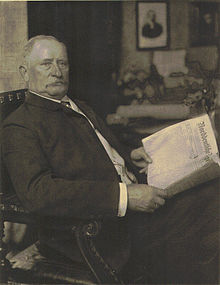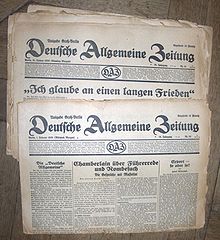German General Newspaper (1919–1945)
The Deutsche Allgemeine Zeitung (DAZ) appeared in Berlin from 1861 to 1945 . Until the end of 1918 it was called the Norddeutsche Allgemeine Zeitung .
history
Monarchy: "Bismarck's House Postille", conservative "Government Gazette" until 1917
It arose from the Leipziger Allgemeine Zeitung , founded in 1837 and published by Heinrich Brockhaus . His son Eduard Brockhaus not only published the paper, but also edited it himself from 1857 to 1883. Its political orientation also shaped the newspaper: Although the social democrat Wilhelm Liebknecht was part of the founding editorial team, the newspaper soon developed a nationally liberal to conservative profile.
In 1862 August Braß (1818–1876) bought the newspaper and headed the editorial department until 1872, from which he left after it was sold because he was reluctant to be demoted to "Bismarck's clerk" and to submit every leading article to the government.
The shareholders from 1872 belonged to the Hamburg circle of friends around the Reich Chancellor Otto von Bismarck , who was led by Albertus Ohlendorff and his brother Heinrich . In the initial phase, the Norddeutsche Bank was another key shareholder in order to provide the required purchase price of 800,000 marks. The newspaper was always close to the government ("Bismarck's house post "), and was at times financed directly by a reptile fund of the Foreign Office . The circulation of the newspaper under his successor Emil Pindter (1836–1897) fell by half to 5,000. The paper went mainly to senior officials and other newspaper editors. In 1894/95 Martin Griesemann took over the editor-in-chief, who often had to be represented by the publishing director Count Rudolph von Westarp due to illness. After Griesemann's death in 1897, Wilhelm Lauser took over the helm, followed by Otto Runge, who headed the paper until 1917.
1917–1920: Attempt to establish the NAZ / DAZ as a liberal-conservative German "Times"
In 1917, the publisher Reimar Hobbing acquired the newspaper, which had been “official” until then, and was to give it a democratic profile in the German Empire shortly before its collapse with the aim of creating a German Times . Liberal intellectuals such as Otto Flake , who briefly headed the features section, could be won over to work. In addition, important historians such as the then twenty-two-year-old Egmont Zechlin and Friedrich Meinecke ( founding rector of the Free University of Berlin after the Second World War ) worked for the paper.
After the end of the First World War , the Norddeutsche Allgemeine was re-established as DAZ in Berlin on November 12, 1918 , after the workers 'and soldiers' council under Felix Stössinger had occupied the newspaper's rooms in the first two days of the revolution and the newspaper appeared under the heading "Internationale" . The new owner Reimar Hobbing received support from Otto Karl Stollberg in transforming it into a DAZ . During the time of the German Empire and the Weimar Republic , the DAZ was one of the best-known and most renowned newspapers internationally, alongside the Berliner Tageblatt , the Vossische Zeitung and the Frankfurter Zeitung . Because of this, the deficit newspaper was able to survive. In terms of orientation, it was more conservative and state-sponsored than the other three newspapers.
1920–1933: The Stinnes and “Ruhrlade” era: right-wing conservative mouthpiece for heavy industry on the Ruhr
From 1920 to 1924 Hugo Stinnes (industrialist and Reichstag member of the DVP ) owned the DAZ after the heirs of the publisher Hobbing sold. He first appointed the government spokesman Rudolf Cuno as editor-in-chief, the former naval attaché in Turkey, Hans Humann, was appointed as the publishing director, the first official act of the previous deputy editor-in-chief, the Swiss Max Rudolf Kaufmann , an old liberal adversary from the common days in Constantinople, threw out. Otto Gysae , writer and, like Humann, a German national and former naval officer, worked from 1920 to 1923 as head of the feature pages as the successor to the liberal Flake. From 1922 to 1925 the former SPD Reichstag deputy Paul Lensch headed the editorial department, who had previously headed the foreign policy department and from 1914 to 1918 he worked for the Lensch-Cunow-Haenisch group in the SPD and for the circle around Alexander Parvus (1910-1914 economic policy Adviser to the Young Turks in Constantinople). During this time, the paper embarked on an increasingly conservative course and was even banned for a short time at the end of 1922 because it supposedly had supported the Kapp Putsch . The editor-in-chief Lensch - a former SPD party leftist in the vicinity of Rosa Luxemburg - was expelled from the SPD. After Lensch's death in 1925, Fritz Klein became editor-in-chief.
In mid-August 1925, at the beginning of the decline of the Stinnes empire, the newspaper was sold together with the Norddeutsche Buchdruckerei- und Verlags AG for 3 million marks to a Berlin consortium led by the paper industrialist Walter Salinger and the democratic Reichstag candidate and former National Liberal MP August Weber . The “right-wing press” feared that “national” circles ”might lose power over this“ important organ ”, although it was assured that the political direction of the newspaper would be maintained. Finally, the DAZ swung more and more on a right-conservative-anti-republican course, similar to parts of the middle class around the DVP. This intensified after Gustav Stresemann's death in 1929. At the end of the twenties it became the mouthpiece of the Ruhrlade , an elite club of the most important Ruhr industrialists who had acquired the majority of shares in the DAZ. In the late phase of the republic, the paper supported the policy of Chancellor Brüning.
dictatorship
In 1933 there was a brief ban because of an article that had made Hitler angry. The owners of the DAZ contributed Karl Silex to the post of chief editor, to this perceived to 1943rd In the following years, Silex tried to maintain the right-wing conservative stance of the paper and thus to secure a minimum of independence from the National Socialists. De facto, however, this meant that even minor deviations from the language regulations of the Propaganda Ministry resulted in drastic sanctions - personal consequences, and several days of publication bans. Adolf Hitler intervened personally in 1938 because of a report by the London correspondent Carl Erdmann Graf Pückler about preparations for war in London, as this contradicted the official line - exposure of the Godesberg and Munich conferences as well as the appeasement policy of the British Prime Minister Arthur Neville Chamberlain .
With the beginning of the Second World War, the pressure on the DAZ editorial team also increased . Several editors and freelancers were also active for the newly founded newspaper Das Reich , with which the Propaganda Ministry wanted to establish a counterweight to English news magazines such as the Observer . In 1943, Silex went to the Navy in protest against the necromancer by the Propaganda Ministry and Otmar Best took over the management of the editorial office until his dismissal in March 1945. The DAZ was one of the last Berlin newspapers to appear until April 24, 1945.
literature
- Robert Schmitt Scheubel: In the center. A foray not only through the music features of the Deutsche Allgemeine Zeitung 1923–1931. consassis.de, Berlin 2010, ISBN 978-3-937416-26-7 .
- Ursula von Kardorff : Berlin records 1942 to 1945. Deutscher Taschenbuch Verlag, Munich 1994, ISBN 3-423-30414-6
- Heinz-Dietrich Fischer: German general newspaper. In: H.-D. Fischer (Hrsg.): German newspapers from the 17th to the 20th century. Verlag Documentation, Pullach 1972, ISBN 3-7940-3602-6 , pp. 269-281.
- Karl Silex: With comment. Life report of a journalist. S. Fischer, Frankfurt am Main 1968.
- Reinhard Schwarz: Emil Pindter as an officious editor and "critic" Otto v. Bismarck's. Peter Lang, Frankfurt / M. 1984, ISBN 3-8204-5546-9 .
- Norddeutsche Allgemeine Zeitung . In: Meyers Großes Konversations-Lexikon . 6th edition. Volume 14, Bibliographisches Institut, Leipzig / Vienna 1908, p. 752 .
Web links
- Link to digital copies of the Norddeutsche Allgemeine Zeitung
- Link to digital copies of the Deutsche Allgemeine Zeitung
- Entry of the NAZ and the DAZ in the database of the Berlin daily newspapers.
Individual evidence
- ↑ Max v. Schinckel : Memoirs . Self-published by Hartung, Hamburg 1929, p. 216.
- ^ Gordon A. Craig : Deutsche Geschichte 1866-1945. Translated from the English by Karl Heinz Siber. 2nd Edition. Beck, Munich 1999, ISBN 3-406-42106-7 , p. 87.
- ↑ Max Rudolf Kaufmann: Experiences in Turkey 50 years ago . In: Journal for Cultural Exchange , Volume 12, Issue 2/3, Institute for Foreign Relations, pp. 237–241 (1962).
- ↑ Stinnes Concerns . In: Newcastle Morning Herald and Miners' Advocate , Newcastle, NSW, Australia, August 24, 1925, p. 5.
- ^ Volksstimme , Magdeburg, August 25, 1925, p. 2.
- ^ Norbert Frei , Johannes Schmitz: Journalism in the Third Reich. CH Beck, Munich 1989, ISBN 3-406-33131-9 , p. 16 and Karl Silex: With comment. Life report of a journalist . S. Fischer Verlag, Frankfurt / M. 1968, p. 132.
- ^ Haug von Kuenheim : Citizens in a balancing act . In: Süddeutsche Zeitung , August 25, 2003, series (XXXVIII). (In contrast to what Kuenheim presented there, the ban on the DAZ was not only threatened, but actually actually took place.)
- ^ Karl Silex: With Commentary , p. 197 f.
- ↑ Ursula von Kardorff: Berlin records 1942 to 1945 , p. 396.
- ↑ Ursula von Kardorff : Berlin records 1942 to 1945 , p. 290, note 2 for February 9, 1945

